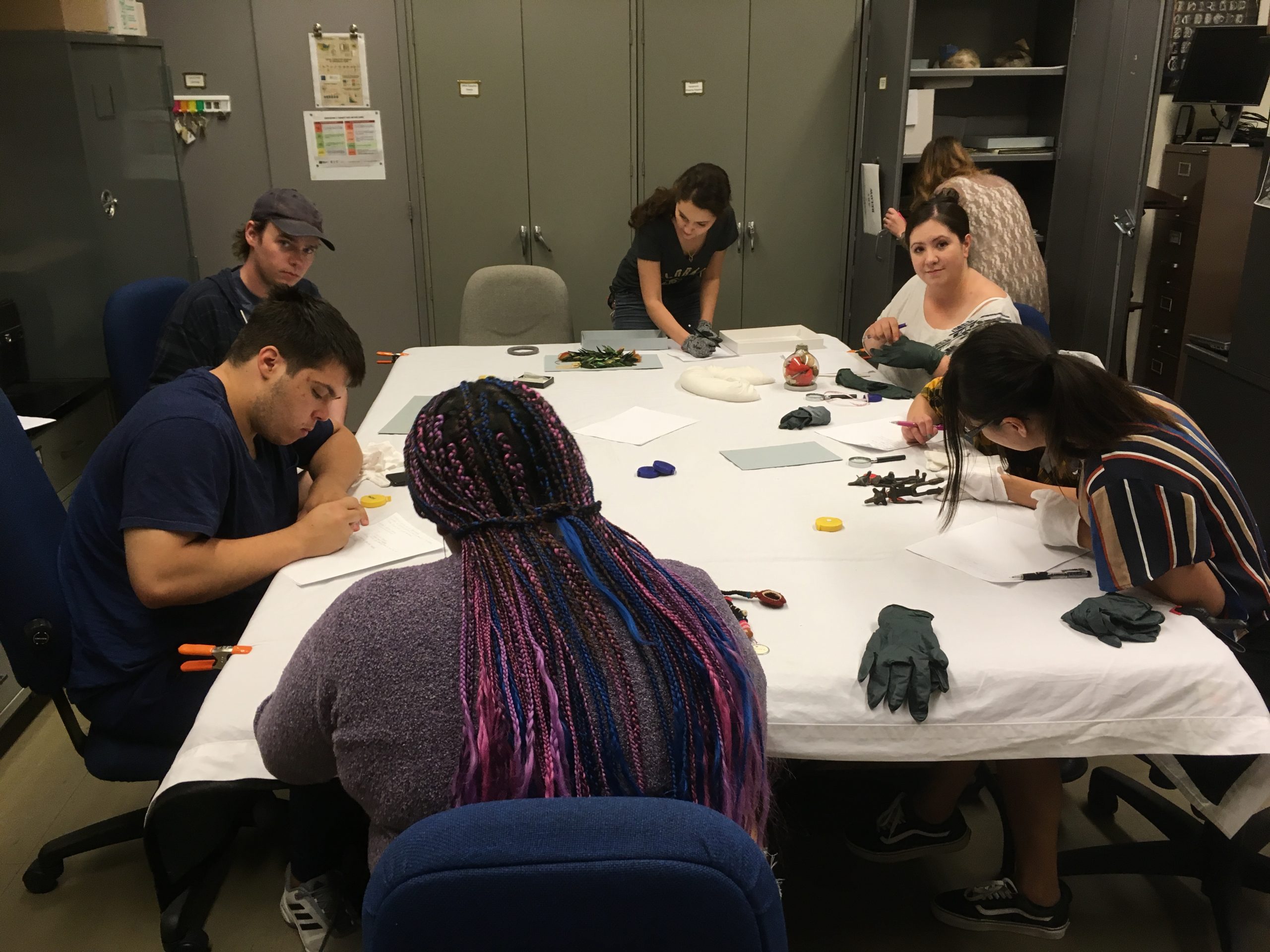Guidelines in Action: The University of Colorado Museum Studies Program

Figure 1: Students “close looking” in the collections research class, 2020.
In 2017 the Indian Arts Research Center at the School for Advanced Research first published a new resource known as the Guidelines for Collaboration. Drawing from decades of case studies and three years of focused work with Native and non-Native museum professionals, cultural leaders, and artists, the Guidelines provide a series of methods for how museums and source communities can work together across two-way learning opportunities. Today the Guidelines are used in classrooms, museums, cultural institutions, tribal communities, and elsewhere.
Guidelines in Action is a series of guest posts highlighting stories from the field.
Guest post by Jen Shannon, curator and associate professor of cultural anthropology at the University of Colorado, Boulder
The guidelines have become most integrated into our teaching through our hands-on training of future collections managers in the anthropology section of our museum. —Jen Shannon, University of Colorado, Boulder
I am a museum curator and associate professor in anthropology and museum studies at the University of Colorado, Boulder. Our program is associated with a public natural history museum on campus, where I teach classes in museum studies and collections research. I have found the SAR Guidelines for Collaboration website to be an excellent resource for teaching. Their brevity, and their direct and clear language, makes the guidelines powerful and incredibly useful in undergraduate and graduate classes.
I teach a first-year graduate course, Introduction to Museum Studies, that is a requirement for students in our museum and field studies program. The course includes all tracks from the program—future collections managers, museum educators, administrators, and exhibit developers. They come from different cognate disciplines like botany, zoology, paleontology, art history, and anthropology. However, in a natural history museum anyone may come into contact with Native visitors or members of a delegation participating in a consultation. From the visitor services staff at the reception desk to someone in a break room, the guidelines for museums are presented as a resource to help staff feel prepared to provide a more welcoming experience to Native community members in the museum.
In my Collections Research in Cultural Anthropology course for undergraduate and graduate students, the guidelines are required reading during our unit on “connecting collections to communities” and the focus of class discussion (figure 1). In class, we learn about collaboration and why it is important. But few resources help students understand how to put it into practice, and the guidelines do this in a way that students appreciate, in very few pages!

The guidelines have become most integrated into our teaching through our hands-on training of future collections managers in the anthropology section of our museum. In our program, students are also paid collections manager assistants, working in the museum to practice what they are learning. They are note takers during repatriation consultations, and they prepare collections for and assist in hosting community visits to collections. Students in our program are also required to produce a thesis or a project to graduate, and several have incorporated the guidelines into their projects.
Emma Noffsinger based her master’s project directly on the SAR Guidelines. She took one bullet point from the museum guidelines—“Collections work: Send relevant collections history and context information to the community prior to the visit”—and made the process to prepare collections for review the focus of her work. She produced collections review binders to prepare for community reviews of Hopi and Zuni items in our care. Master’s projects require that students create something that benefits the profession beyond the project alone, so Emma also developed a set of procedures to share with others in her field, expanding that one bullet point from the SAR Guidelines into a supplemental ten–page guide, Preparing Collections for Review: A Guide for Collections Managers. The process she describes was based in our particular museum. Depending on the museum, other staff such as curators or conservators may be the ones to prepare these kinds of materials.
The steps in the supplement Emma created for the SAR Guidelines include Define Project, Survey Museum Documentation, Expanded Inventory, Object Research, Preparing Object Reports and Organizing Binder, and Contact Tribes and Share Information (figure 2). She provides a flow chart for developing a collections review binder in preparation for a community visit.

Figure 2: Emma Noffsinger’s workflow guiding collections managers in preparing collections for community collaboration.
Emma explains in a 2018 article she published about her project in the Informal Learning Review that the SAR Guidelines for Collaboration are “meant to be short and approachable” but leave out the detailed work required of collection managers. She notes, “Preparing collections for review is one of the most important steps in pursuing a collaborative relationship and requires a significant amount of the collections manager’s time and resources. . . . A collection manager’s involvement in collaboration begins by gaining intellectual and physical control of a collection, and by making collections accessible . . . good for collaboration [and] for the museum as well.”
The guidelines have become most integrated into our teaching through our hands-on training of future collections managers in the anthropology section of our museum. In our program, students are also paid collections manager assistants, working in the museum to practice what they are learning. They are note takers during repatriationEmma explains in a 2018 article she published about her project in the Informal Learning Review that the SAR Guidelines for Collaboration are “meant to be short and approachable” but leave out the detailed work required of collection managers. She notes, “Preparing collections for review is one of the most important steps in pursuing a collaborative relationship and requires a significant amount of the collections manager’s time and resources. . . . A collection manager’s involvement in collaboration begins by gaining intellectual and physical control of a collection, and by making collections accessible . . . good for collaboration [and] for the museum as well.”
Jane Richardson’s master’s project developed culturally appropriate collections management policies in collaboration with the steering committee of the Mandan Hidatsa Arikara Nation’s new interpretive center. Her contribution beyond the project was a Museum Toolkit that included community surveys to aid tribal museums in developing their policies, a collections development plan, and a series of resources. She looked to the SAR Guidelines for Collaboration in planning her project, noting in particular the guidelines regarding community representatives. Jane worked with a group of elders and tribal officials and tourism specialists, a diverse group of people who came together to discuss the policies from different perspectives. She said this was “one of the most meaningful parts” of her work with the community.
Emma and Jane, and others like them, use the SAR Guidelines as a foundation on which to develop how they, and their profession, can promote and contribute to meaningful collaborations between Native communities and museums. I look forward to seeing students continue to be inspired by the guidelines in my classes, and I invite university instructors to consider including them as required reading in museum studies and museum anthropology classes, and for students interested in museum careers more broadly.
Learn more about the Guidelines for Collaboration here.
The SAR Guidelines for Collaboration are available to anyone online, however, as many collaborators and interested parties have limited access to the Internet, the Guidelines are also available as a hard copy. Contact Elysia Poon at poon@sarsf.org for more information.

